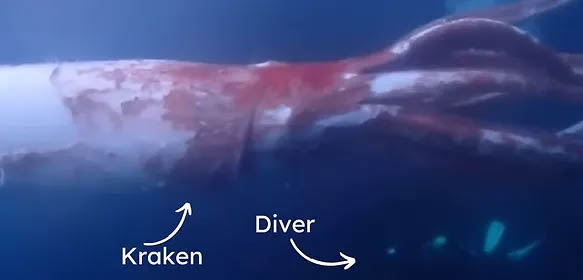It’s official – the Kraken is real. And it’s not staying in the abyss.
If you’re not up to speed on your nautical lore, the Kraken is arguably the most famous legend of the deep — a massive sea serpent with a propensity for grabbing ships and hauling them down to Davy Jones’ locker. Move over Captain Ahab, the Kraken eats the white whale for dinner.
he origins of the Kraken mythology can be traced back to the early 1700’s when Norwegian sailors began describing an octopus or squid-like creature that was so large it was capable of sinking ships. According to early re-tellings, sometimes it did. But that myth is now more truth than fiction.
The word “kraken,” as we know it today, derives from the Old Norse term ‘krake,’ referring to a “pole” or “stake” from a malformed or crooked tree. Comparing the mythical sea serpent to a misshapen tree trunk seems apt when imagining sailors watching an enormous cephalopod gliding ominously through through dark waters.
But as much as sailors love a good sea monster, modern science has shown us that there is no octopus big enough to drag down a ship. There is, however, a giant squid capable of the feat. Enter the unsettling reality that is Architeuthis dux. The name is hard to pronounce, but its ethos is very simple — being the most dangerous predator in the ocean.
To add a little more uneasiness to your aquatic dreams, on the rare occasion giant squid have been spotted they have almost always been 1) observed by submersibles at the ocean’s deepest depths, or 2) dead and washed ashore.
Not anymore
Japanese divers have captured incredible footage of a giant squid not only swimming at the surface, but also swimming with divers. While it seems unfathomably risky to swim within range of one of those tentacles, no one was harmed during the encounter.
This begs the question — why was the enormous predator swimming at the surface? sickness? injury? In search of food?
If the massive invertebrate was hungry, we wouldn’t be seeing the footage from the divers because, well… you know. And while we’re not cephalopod experts (obviously), the flaking skin on its mantle (that being the large bulbous ‘head’) seems to indicate a sickness of some kind.
In an article in the Japan Times, the divers, Yosuke Tanaka and his wife Miki — operators of a diving business in Toyooka city in the Hyogo region — seemed to corroborate that theory, stating: “We didn’t see the kinds of agile movements that many fish and marine creatures normally show,” he said. “Its tentacles and fins were moving very slowly.”
Tanaka also added: “I could see its tentacles moving. I thought it would be dangerous to be grabbed hard by them and taken off somewhere.” Good observation.
Some of the available footage describes the squid as being 8′ (2.5 m) in length, which refers only to its mantle length. Because squid can stretch their limbs (they have 8 arms and 2 tentacles), the length of their appendages is generally not included in the measurement. Taking that into consideration, and using the diver as a reference, it appears the squid’s total length is somewhere in the 20-25′ foot range. Un-stretched. And not hunting.
On that note, we recommend being wary if you’re boating in areas where giant squid are known to exist, or if your sonar shows you’re traveling over a deep trench of immeasurable depth. The Kraken may no longer be hiding in the deep. It might be lurking just below the surface.
This will also add a little more excitement for ocean boaters who are already encountering new phenomena, like mako sharks falling from the sky and Great Whites obliterating diver tanks.






